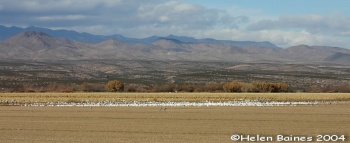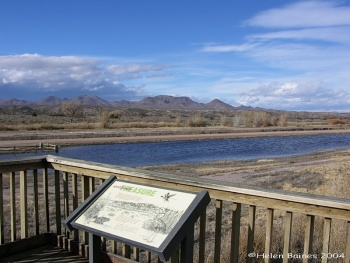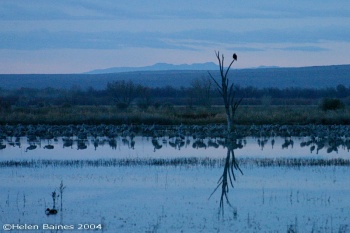(Picture placement) |
m |
||
| Line 9: | Line 9: | ||
===Notable Species=== | ===Notable Species=== | ||
Thousands of [[Sandhill Crane]]s and [[Snow Goose|Snow Geese]] in the winter. [[Bald Eagle]]s are easy to see at the crane and waterfowl roosts. | Thousands of [[Sandhill Crane]]s and [[Snow Goose|Snow Geese]] in the winter. [[Bald Eagle]]s are easy to see at the crane and waterfowl roosts. | ||
| − | |||
===Rarities=== | ===Rarities=== | ||
Revision as of 18:42, 1 January 2017
Overview
Bosque del Apache NWR is 57,331 acres (89.58 mi²) in size and located on the Rio Grande River, 20 miles south of Socorro in New Mexico. It is famous for the huge numbers of wintering cranes, ducks, geese and eagles. These are found in the floodplain part of the refuge, where the driveable loop tours are also located. The floodplain area is surrounded by arid foothills and mesas which are accessible for hiking. About 350 species of birds have been seen here.
Birds
Notable Species
Thousands of Sandhill Cranes and Snow Geese in the winter. Bald Eagles are easy to see at the crane and waterfowl roosts.
Rarities
In mid-July, 2013 a Rufous-necked Wood-Rail was found - see ABA Rare Bird Alert. A Sungrebe was found there in 2008.
Check-list
Birds you can see here include:
Fulvous Whistling-Duck, Greater White-fronted Goose, Snow Goose, Ross's Goose, Cackling Goose, Canada Goose, Trumpeter Swan, Tundra Swan, Wood Duck, Gadwall, Eurasian Wigeon, American Wigeon, Mallard, Blue-winged Teal, Cinnamon Teal, Northern Shoveler, Northern Pintail, Green-winged Teal, Canvasback, Redhead, Ring-necked Duck, Greater Scaup, Lesser Scaup, Bufflehead, Common Goldeneye, Hooded Merganser, Common Merganser, Red-breasted Merganser, Ruddy Duck, Scaled Quail, Gambel's Quail, Ring-necked Pheasant, Wild Turkey, Pied-billed Grebe, Eared Grebe, Western Grebe, Clark's Grebe, Double-crested Cormorant, Neotropic Cormorant, American White Pelican, American Bittern, Least Bittern, Great Blue Heron, Great Egret, Snowy Egret, Little Blue Heron, Tricolored Heron, Cattle Egret, Green Heron, Black-crowned Night-Heron, Yellow-crowned Night-Heron, White Ibis, Glossy Ibis, White-faced Ibis, Turkey Vulture, Osprey, White-tailed Kite, Golden Eagle, Northern Harrier, Sharp-shinned Hawk, Cooper's Hawk, Bald Eagle, Common Black Hawk, Harris's Hawk, Swainson's Hawk, Red-tailed Hawk, Rough-legged Hawk, Ferruginous Hawk, Virginia Rail, Sora, Common Gallinule, American Coot, Sandhill Crane, Whooping Crane, Black-necked Stilt, American Avocet, Black-bellied Plover, American Golden Plover, Snowy Plover, Semipalmated Plover, Killdeer, Spotted Sandpiper, Solitary Sandpiper, Greater Yellowlegs, Willet, Lesser Yellowlegs, Long-billed Curlew, Marbled Godwit, Stilt Sandpiper, Dunlin, Baird's Sandpiper, Least Sandpiper, Pectoral Sandpiper, Semipalmated Sandpiper, Western Sandpiper, Long-billed Dowitcher, Wilson's Snipe, Wilson's Phalarope, Red-necked Phalarope, Bonaparte's Gull, Franklin's Gull, Ring-billed Gull, California Gull, American Herring Gull, Black Tern, Forster's Tern, Rock Dove, Eurasian Collared-Dove, Inca Dove, White-winged Dove, Mourning Dove, Yellow-billed Cuckoo, Greater Roadrunner, Barn Owl, Western Screech-Owl, Great Horned Owl, Burrowing Owl, Lesser Nighthawk, Common Nighthawk, Common Poorwill, White-throated Swift, Black-chinned Hummingbird, Broad-tailed Hummingbird, Rufous Hummingbird, Calliope Hummingbird, Belted Kingfisher, Red-naped Sapsucker, Ladder-backed Woodpecker, Downy Woodpecker, Hairy Woodpecker, Northern Flicker, American Kestrel, Merlin, Aplomado Falcon, Peregrine Falcon, Prairie Falcon, Olive-sided Flycatcher, Western Wood-Pewee, Willow Flycatcher, Hammond's Flycatcher, Gray Flycatcher, Dusky Flycatcher, Cordilleran Flycatcher, Black Phoebe, Eastern Phoebe, Say's Phoebe, Vermilion Flycatcher, Ash-throated Flycatcher, Cassin's Kingbird, Western Kingbird, Eastern Kingbird, Loggerhead Shrike, Northern Shrike, Bell's Vireo, Plumbeous Vireo, Cassin's Vireo, Warbling Vireo, Pinyon Jay, Steller's Jay, Woodhouse's Scrub Jay, American Crow, Chihuahuan Raven, Common Raven, Horned Lark, Northern Rough-winged Swallow, Tree Swallow, Violet-green Swallow, Bank Swallow, Barn Swallow, Mountain Chickadee, Verdin, Bushtit, Red-breasted Nuthatch, White-breasted Nuthatch, Brown Creeper, Rock Wren, Canyon Wren, House Wren, Marsh Wren, Carolina Wren, Bewick's Wren, Cactus Wren, Blue-gray Gnatcatcher, Black-tailed Gnatcatcher, American Dipper, Golden-crowned Kinglet, Ruby-crowned Kinglet, Eastern Bluebird, Western Bluebird, Mountain Bluebird, Townsend's Solitaire, Hermit Thrush, American Robin, Gray Catbird, Curve-billed Thrasher, Crissal Thrasher, Sage Thrasher, Northern Mockingbird, European Starling, American Pipit, Cedar Waxwing, Phainopepla, Chestnut-collared Longspur, McCown's Longspur, Orange-crowned Warbler, Lucy's Warbler, Virginia's Warbler, MacGillivray's Warbler, Common Yellowthroat, Yellow Warbler, Yellow-rumped Warbler, Grace's Warbler, Black-throated Gray Warbler, Townsend's Warbler, Wilson's Warbler, Yellow-breasted Chat, Cassin's Sparrow, Chipping Sparrow, Clay-colored Sparrow, Brewer's Sparrow, Black-throated Sparrow, Lark Sparrow, Lark Bunting, Dark-eyed Junco, White-crowned Sparrow, Golden-crowned Sparrow, Harris's Sparrow, White-throated Sparrow, Sagebrush Sparrow, Vesper Sparrow, Savannah Sparrow, Song Sparrow, Lincoln's Sparrow, Swamp Sparrow, Canyon Towhee, Rufous-crowned Sparrow, Green-tailed Towhee, Spotted Towhee, Hepatic Tanager, Summer Tanager, Western Tanager, Pyrrhuloxia, Rose-breasted Grosbeak, Black-headed Grosbeak, Blue Grosbeak, Lazuli Bunting, Indigo Bunting, Dickcissel, Red-winged Blackbird, Western Meadowlark, Eastern Meadowlark, Yellow-headed Blackbird, Brewer's Blackbird, Common Grackle, Great-tailed Grackle, Brown-headed Cowbird, Bullock's Oriole, Scott's Oriole, House Finch, Cassin's Finch, Red Crossbill, Pine Siskin, Lesser Goldfinch, American Goldfinch, Evening Grosbeak, House Sparrow
Other Wildlife
A folder called "watchable wildlife" is available in the refuge as well as on the web (see below in External Links). This details both birds, mammals, reptiles, amphibians, and fish found in the area. Among the most commonly seen mammals are Mule Deer, Collared Peccary and Rock Squirrel, and e.g., Striped and Spotted Skunks, Coyote, etc, are relatively common but more rarely seen. Even Mountain Lion can occasionally be seen in the publicly available areas of the refuge.
Site Information
History and Use
Bosque del Apache NWR was established in 1939. The central area contains managed flood plain with seasonally wet ponds, but surrounding that are areas managed with farming which produces winter food for e.g., cranes.
Areas of Interest
- A 12 mile tour loop: open daily, 1 hour before sunrise - 1 hour after sunset. This is a one-way graded gravel road with a 2-way cut-off giving two shorter loops: Farm Loop (7.5 miles) and Marsh Loop (7 miles).
- Annual Festival of the Cranes - 6 days every year in mid-November
Access and Facilities

Click photo to see a larger image
Photo by HelenB
- Entrance fees: $5 per day per passenger vehicle (including all occupants) and motorcycles
- Annual Pass: $15 for 12 months
- Visitor Center: open daily Sep - May, 8am-4pm; June - Aug, only open Thurs - Mon, 8am-4pm (i.e. closed Tues & Wed). Closed for Thanksgiving, Christmas and New Year's Day, and July 4th
- Restrooms are located near the visitor center and porta-potties are available around the tour loops from November to February
- Viewing decks
- Hiking trails of varying lengths - 1.5 to 10 miles
- Tour loops
- The Seasonal Tour Road is only open April through September. During the winter this area is reserved as a roost area for the cranes and eagles.
- Pets must be confined or on a leash and are not allowed in the visitor center
- Camping is not allowed, but there is an RV park north of the Refuge
Contact Details
- Mailing Address: P.O. Box 280, San Antonio, NM 87832
- By Phone: Office: (575) 835-1828
- By email: RO/R2/FWS/[email protected]
External Links
- Official USFWS website
- Watchable Wildlife list in downloadable PDF form
- Friends of Bosque del Apache NWR
- Annual Festival of the Cranes
- eBird bar chart of bird observations at Bosque del Apache NWR







